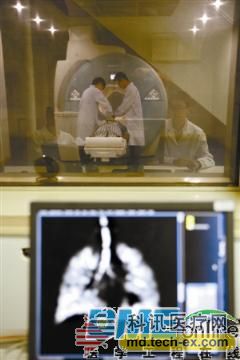Release date: 2015-09-23

The Wuhan Institute of Physics and Mathematics of the Chinese Academy of Sciences announced on the 7th that it successfully developed the first hyperpolarized gas lung magnetic resonance imaging equipment in China and obtained the first three-dimensional, clear lung magnetic resonance image. This may revolutionize the diagnosis and treatment of lung diseases.
In recent years, due to various factors such as smoking, air pollution, and aging population, the incidence of lung diseases such as lung cancer has increased year by year. According to a report released by the World Health Organization in 2013, lower respiratory tract infections, chronic obstructive pulmonary disease and lung cancer have ranked among the top ten causes of death in our country.
Scientific testing is a prerequisite for precision treatment. In the diagnosis and treatment of lung diseases, chest X-ray, CT and other detection methods are commonly used. However, the radioactivity of these technologies has certain damage to the human body, and it cannot provide an important indicator for measuring the health of the lungs, that is, the index of lung gas-gas exchange and gas-blood exchange function. Although ordinary magnetic resonance imaging technology has no radioactive damage and can image the structure and function of most tissues and organs of the human body, the lung is its only "blind zone" because the gas is mostly gas and cavity tissue. Above is a black cavity area.
"Currently there is no clinical imaging device that can visually detect the gas exchange function of the lungs without invasion and radiation, which hinders the early diagnosis and treatment of lung diseases." The Institute of Physics and Mathematics, Chinese Academy of Sciences Zhou Xin, a researcher at the State Key Laboratory of Atomic and Molecular Physics, said, "In order to 'light up' the lungs, to clearly and intuitively observe the structural and functional information of the lungs, we must obtain a gas signal with a signal enhancement greater than tens of thousands of times."
The Wuhan Institute of Physics and Mathematics of the Chinese Academy of Sciences is one of the earliest research institutes engaged in gas-enhanced magnetic resonance in the world, with nearly 30 years of research and development. Zhou Xin led the team to use the core technology of cascade laser light pump to successfully develop a gas polarization device with high gas output rate, automatic control and movable, which can enhance the polarization of helium nucleus spin by more than 44,000 times. . They developed a new type of human "vest" high-sensitivity lung imaging probe that improves the excitation uniformity and reception efficiency of the magnetic resonance signals in the lungs. They also proposed a series of new pulmonary function spectroscopy and imaging methods to efficiently and quantitatively obtain kinetic and imaging information on lung gas-gas exchange and gas-blood exchange.
Recently, the team cooperated with Professor Wu Guangyao of the Central South Hospital of Wuhan University to conduct a preclinical lung disease research and successfully obtained a gas magnetic resonance image of an asthma patient. This is also the first three-dimensional lung gas image map in China. The team has applied for 30 national invention patents, and the relevant research results have been published in international professional journals such as Magnetic Resonance Medicine.
It is understood that the device has proven its effectiveness and superiority in the diagnosis and prognosis evaluation of various lung diseases such as asthma, chronic obstructive pulmonary disease and pulmonary fibrosis. It is understood that the instrument has not yet been applied to the clinic, but the medical community at home and abroad have realized the potential of this technology, and is carrying out relevant research, and strive to realize the clinical application of this technology as soon as possible.
Source: Xinhuanet
ZHANGJIAGANG DINSHENGLIN TRADING CO.,LTD , https://www.dslhouse.com